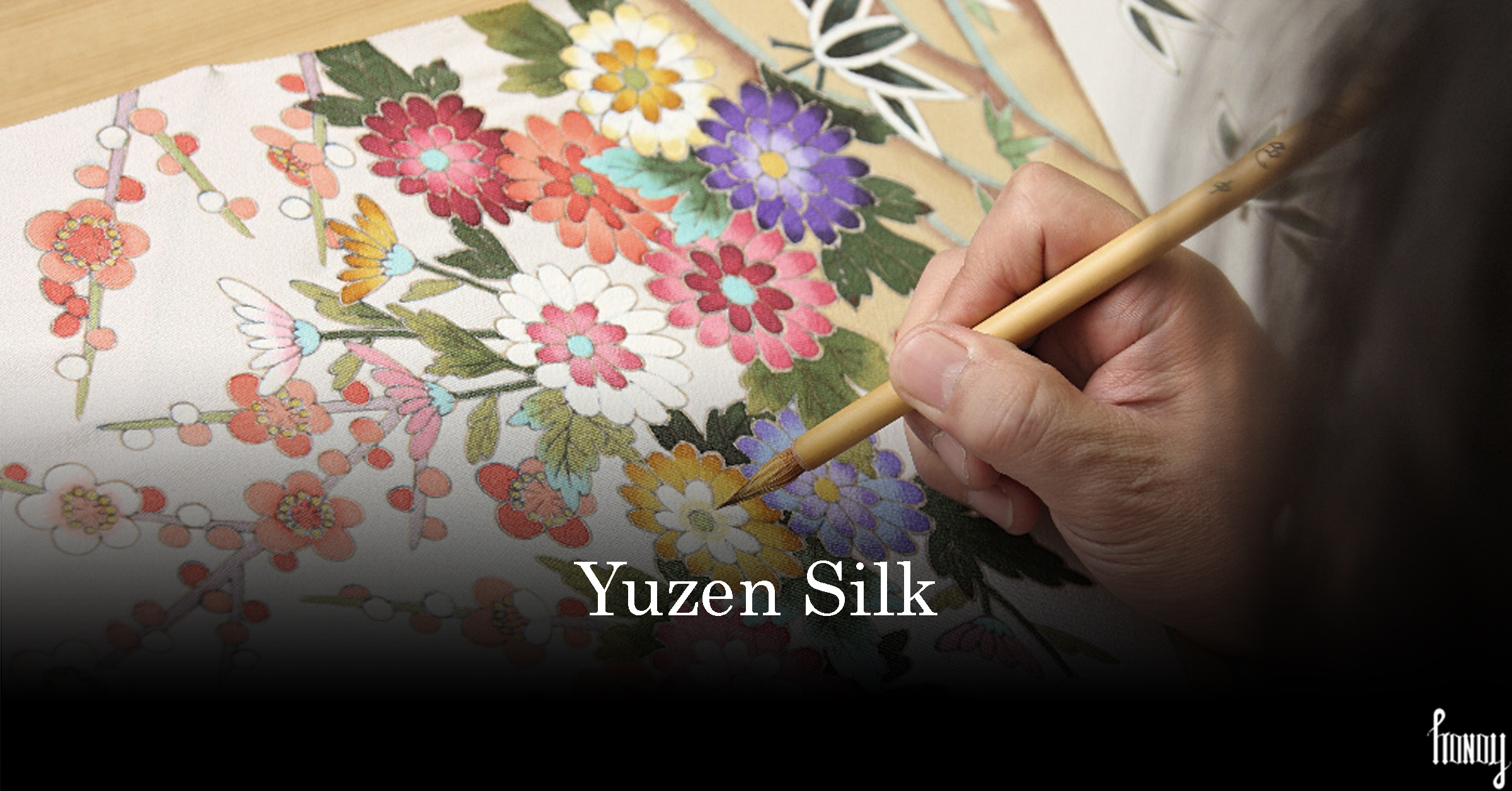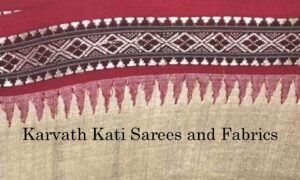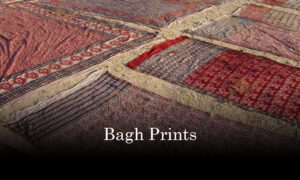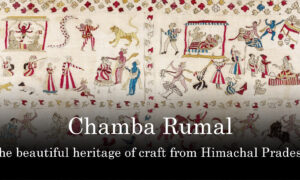Introduction
Among Japan’s rich tapestry of traditional crafts, Yuzen silk stands as a testament to the nation’s artistry and meticulous craftsmanship. Renowned for its intricate patterns and vibrant colors, Yuzen silk is often used in kimono design, blending tradition with artistic ingenuity. Originating in the 17th century, this craft has become a cultural icon, symbolizing Japan’s dedication to beauty, nature, and precision. As we delve deeper, we will explore its historical evolution, cultural significance, unique processes, and its journey into the modern world.
“Yuzen silk captures the soul of Kyoto—its elegance, its traditions, and its vivid seasons,”
– Anonymous Kyoto Artisan
Historical Evolution of Yuzen Silk

The story of Yuzen silk begins in the Edo period (1603–1868), a time of cultural flourishing in Japan. The technique is attributed to Miyazaki Yūzen, a fan painter from Kyoto, whose innovative designs revolutionized textile dyeing. His patterns, inspired by natural motifs and landscapes, moved away from the traditional methods of embroidery and weaving, focusing instead on painting directly onto fabric. This approach gave rise to the term Yuzen-zome, meaning “Yuzen dyeing.”
“A kimono is more than attire—it is a canvas where stories of nature and imagination unfold.”
– Yuzensai Miyazaki
By the 18th century, Yuzen silk had gained immense popularity, particularly among the merchant class, who sought affordable yet elaborate alternatives to the expensive nishijin-ori woven fabrics. The craft’s reputation soared, with Kyoto becoming the epicenter of Yuzen production. In 1976, the Japanese government officially designated Kyo-Yuzen, a regional variant, as an Important Intangible Cultural Property, solidifying its cultural legacy.
Cultural Significance
Yuzen silk occupies a revered place in Japanese culture. Its intricate patterns, often depicting seasonal flowers, birds, and natural landscapes, reflect a deep connection to nature and the changing seasons—an essential aspect of Japanese aesthetics.
Traditionally, Yuzen silk was used in the creation of kimonos for significant occasions such as weddings, tea ceremonies, and festivals. Each design tells a story, with motifs carrying symbolic meanings. For instance, cherry blossoms represent the transient beauty of life, while cranes signify longevity and good fortune.
Beyond its visual appeal, Yuzen silk is a medium of cultural expression, encapsulating Japan’s heritage and the meticulous artistry of its craftspeople. It serves as a bridge between generations, preserving traditional techniques while adapting to contemporary tastes.
Process
The traditional process of creating Yuzen silk is a meticulous, multi-step craft that requires extraordinary skill and attention to detail. Here’s an in-depth look at the process:
1. Fabric Preparation
- Material: The process begins with high-quality silk fabric, usually plain white.
- Stretching: The silk is stretched tightly over a frame called a tatami to ensure it is flat and smooth for dyeing.
2. Designing the Pattern
- Sketching: A master artist sketches intricate designs directly onto the silk using light ink. Traditional motifs often include nature-inspired themes like flowers, birds, and landscapes.
- Templates: Sometimes, stencils (katagami) are used to guide repetitive or symmetrical patterns.
3. Resist-Paste Application (Itome-Nori)
- Rice Paste: A special resist paste, made from glutinous rice and bran, is applied to the outlined designs. This prevents the dyes from bleeding into unwanted areas.
- Method: The paste is squeezed through a cone-shaped tube, carefully tracing the design lines.
4. Dyeing
- Brush Dyeing: Artisans use fine brushes to apply vibrant, hand-mixed dyes within the paste-outlined sections. They layer and blend colors to achieve depth and subtle gradients, a hallmark of Yuzen.
- Shading Techniques: Gradation dyeing (bokashi) is often used to create soft, natural transitions between colors.
5. Steaming
- After the dyes are applied, the silk is steamed to fix the colors. This process enhances the vibrancy and durability of the dyes.
6. Washing (Mizumoto)
- The fabric is gently washed in water to remove the resist paste and reveal the intricate design in its entirety.
- This stage also softens the silk, giving it its signature luxurious texture.
7. Additional Detailing
- Hand-Painting: Artisans often add final details using delicate brushes and metallic pigments, such as gold and silver.
- Embroidery: In some cases, embroidery is incorporated to enhance the richness of the design.
8. Final Fixation and Finishing
- The silk undergoes a final steaming to set the dyes and ensure durability.
- The fabric is then ironed and inspected for quality before being crafted into kimonos, obi (sashes), or other garments.
This centuries-old craft, pioneered by Yuzensai Miyazaki in Kyoto during the Edo period, is celebrated for its artistry and cultural significance. Despite modern innovations, traditional Yuzen techniques remain highly valued for their exquisite detail and unparalleled craftsmanship.
Modernization
While Yuzen silk remains deeply rooted in tradition, it has also evolved to meet contemporary demands. In recent decades, artisans have adapted the craft to create not only kimonos but also modern apparel, accessories, and home decor. Designers have experimented with bold colors and abstract patterns, appealing to a global audience.
Moreover, advancements in technology have introduced digital techniques that mimic the traditional process, making Yuzen-inspired designs more accessible. However, purists argue that these innovations lack the soul and craftsmanship of hand-dyed Yuzen silk.
Despite these challenges, the craft continues to thrive, thanks to the dedication of artisans and the support of government initiatives. Organizations like the Kyoto Prefectural Government regularly host exhibitions and workshops to promote Kyo-Yuzen, ensuring its survival in the face of modernization.
“Yuzen dyeing stands as a bridge between Japan’s past and present, showcasing how tradition can inspire contemporary design.”
– Yoshiko Shimada (Modern textile artist)
Collaborations with Artists and Designers
Yuzen silk has inspired collaborations with contemporary artists and designers, bridging the gap between tradition and innovation. Esteemed fashion houses such as Issey Miyake and Yohji Yamamoto have incorporated Yuzen-inspired patterns into their collections, showcasing the craft on international runways.
Additionally, collaborations with global brands like LTK (short for Little Tokyo Karesansui) and other international luxury brands have introduced Yuzen silk to a wider audience. These partnerships not only celebrate the artistry of Yuzen but also provide artisans with new opportunities to showcase their skills.
Local artists have also embraced Yuzen as a medium for creative expression, using it to craft modern artworks that blend traditional techniques with contemporary themes. These endeavors highlight the versatility and timeless appeal of Yuzen silk.
Conclusion
Yuzen silk is more than just a fabric; it is a living legacy that embodies Japan’s cultural essence and artistic spirit. From its humble beginnings in the Edo period to its modern adaptations, Yuzen silk has transcended time, evolving while retaining its traditional roots.
As we celebrate this exquisite craft, it is crucial to support the artisans and initiatives that preserve its heritage. Whether through wearing a Yuzen kimono, attending an exhibition, or simply appreciating its beauty, we can contribute to the continuation of this timeless art form. Yuzen silk is not merely a textile; it is a story of tradition, innovation, and the enduring beauty of Japanese craftsmanship. If you have enjoyed reading this blog then please share your thoughts in the comments below and also let me know if I need to add more to this blog.
References
If you wish to know more about this beautiful textile craft of Japan, you can read the following books and visit the websites:
Books:
- Anderson, R. K. (1979). Japanese textiles. Weatherhill.
- A comprehensive overview of traditional Japanese textiles, including techniques like Yuzen dyeing.
- Yokoyama, N., & Matsuda, T. (1982). Kimonos and textiles of Japan. Heibonsha.
- Explores the history and artistry of kimono fabrics, including Yuzen dyeing, with detailed illustrations.
- Nagasaki, I. (2001). The art of Kyo-yuzen: Traditional silk dyeing techniques. Kyoto Arts Press.
- This book focuses specifically on Kyo-Yuzen, highlighting its history, techniques, and significance in Kyoto culture.
- Ishikawa Prefectural Museum of Art. (2022). Kaga-Yuzen: Kimono fabrics expressing traditions and artistic skill. Ishikawa Cultural Heritage.
- Delves into Kaga-Yuzen, another regional variation of Yuzen dyeing, showcasing its unique characteristics.
- Sanders, H. (2010). Textiles of Japan: The thread of life. Tuttle Publishing.
- Offers insights into various Japanese textile crafts, including Yuzen dyeing, with cultural and historical contexts.
Websites:
- Highlighting Japan. (2022). Kaga-Yuzen: Kimono fabrics expressing traditions and artistic skill. Retrieved from Highlighting Japan
- An article describing Kaga-Yuzen’s history, techniques, and modern-day artisans.
- Suigenkyo Online Store. (n.d.). Kyo-Yuzen: The art of Kyoto’s traditional silk painting. Retrieved from Suigenkyo Store
- Introduces Kyo-Yuzen, its origins, and its evolution as a cultural emblem.
- Kyoto Prefectural Government. (n.d.). Traditional industries in Kyoto. Retrieved from Kyoto Prefecture Official Website
- An overview of Kyoto’s rich tradition of crafts, including Yuzen silk dyeing.





























Pingback: No 13 Karvath Kati : Best Crafts Of India Series
hatty2001
April 24, 2025 at 3:07 pm
Awesome post
Stephen3576
May 1, 2025 at 11:10 am
Very good